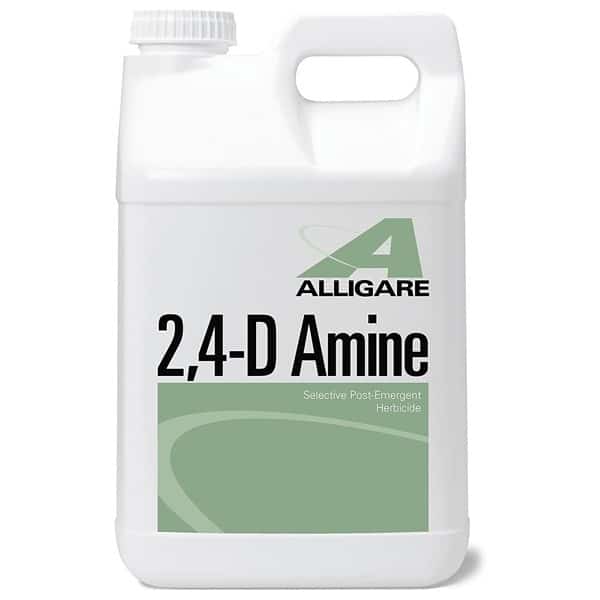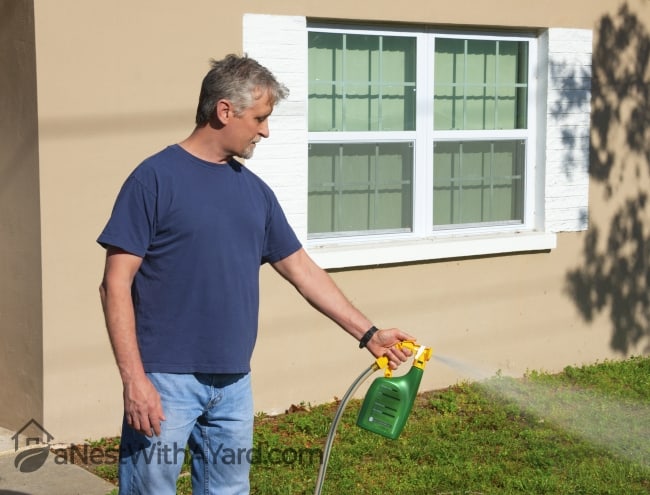Table of Contents
In general, you should use 2.5 oz or 5 tablespoons of 2,4-D per gallon of water. It should be enough to treat 400 square feet of grass. However, you should always check the product label and mixing instructions since different manufacturers produce different levels of potency.
Are you looking for a way to save your weed-laden grass? According to the National Pesticide Information Center, selective herbicide 2,4-D kills broadleaf weeds without destroying most grass species, which probably makes it an excellent solution for vegetation control in your lawn, too.
In my experience, 2,4-D is a highly effective weed killer, as long as you use a proper mix ratio. Even a minor mistake can significantly diminish the effectiveness of this herbicide and result in poor weed control.
So to avoid wasting your money, effort, and time, stay tuned and learn how much 2,4-D you should use per gallon of water!
How Much 2,4-D To Use Per Gallon Of Water?

As I have already told you, you should use the correct amount of 2,4-D if you hope to kill broadleaf weeds. This herbicide does come in ready-to-use form, but if you purchase 2,4-D in liquid concentrate, you must mix it with water before use.
How much 2.4-D amine per gallon of water you should use depends on several factors. My advice is to always read the product label and mixing instructions. The amount of 2,4-D per gallon of water also depends on the application method you choose (hand sprayer or water hose sprayer).
Here are the mixing directions I use for 2.4-D weed killer (I based them on the instructions I have found in an SFGATE article – I like mines better since they are easier to understand):
Mixing 2,4-D For A Backpack Sprayer Or Hand Sprayer
To mix enough herbicide to kill weeds effectively in up to 400 square feet of grass, do this:
- Mix 2.5 ounces (5 tablespoons) of 2.4-D liquid concentrate with a gallon of water.
If you need to cover a bigger lawn, as I do, simply double or triple the amount of ingredients maintaining the same mixing ratio.
To treat up to 800 or 1200 square feet, use the following amount of ingredients:
- Mix 5 ounces of concentrate and 2 gallons of water, or 7.5 ounces of 2,4-D and 3 gallons of water.

Apply this mixture over your grass in an even sweep for proper coverage. Do not repeat my rookie mistake and drench the grass.
According to Dr. Charlie Hart, scientist and market development specialist for Corteva Agriscience, mixing herbicides and surfactants or other additives can be beneficial, but you have to do it in proper order.
If you do it wrong, you might lower the effectiveness of your mixture.
So take my advice and follow these steps:
- Pour ½ of the water into the spray bottle and start the agitation.
- Add 2.4-D and continue agitation.
- Add surfactant into the spray bottle (or other additives) and continue agitation.
- Add the rest of the water to the spray bottle.
If you do not have any surfactants, you can try my trick and use liquid dish soap instead. It will also help 2,4-D stick to broadleaf weeds and increase its effectiveness. To learn more about using dish soap as a sticking and spreading agent for weed killers, check out the video I posted below:
Mixing 2,4-D for A Hose-End Bottle Sprayer

According to H. L. Dooley and A. A. Badiei, who have evaluated different hose-end sprayers for the U. S. Environmental Protection Agency’s Office of Pesticide Programs, hose-end sprayers are easy to use, economical, and quite accurate when used correctly. After using one myself, I can confirm all this too.
If you want to try using 2.4-D with a spray applicator that attaches to the garden hose, you should use 6.5 ounces of concentrate for 1,000 square feet of lawn. Also, set the dial so that it delivers 2.5 ounces of 2.4-D per gallon of water. Don’t add water to the reservoir. The sprayer automatically dilutes the concentrate as water from your hose flows through it.
You can also fill the reservoir to reach a larger area. As I read in an article published by SOLO USA, a reputable manufacturer of the backpack, hand-held, and one-hand compression sprayers, hose-end sprayers typically hold between 16 and 32 ounces of liquid pesticides. The article states that a sprayer set to a higher chemical-to-water ratio produces a more concentrated solution of weed killer and empties the reservoir more quickly than a sprayer set to a lower concentration.
To calculate the total square footage of your lawn, watch this great video I found while I was preparing to mix the 2,4-D:
Extra Tip:
According to a scientific report published by the National Library of Medicine, temperature plays a crucial role in the weed control efficacy of 2,4-D. This research suggests using 2,4-D in lower temperatures can help control broadleaf weeds such as water hemp.
Word Of Warning
I must warn you that 2,4-D is a toxic chemical, as confirmed by Danielle Sedbrook, a professor of organic chemistry at Columbia University. In his words, 2,4-D is the cheapest and most common weed killer in the USA, but it has an ugly side, too. Recent scientific evidence suggests that 2,4-dichloro phenoxy acetic acid can endanger both our health and our environment.
It is too early to be certain, but there are indications this popular weed killer can increase the risk of:
- Cancer (non-Hodgkin’s lymphoma and sarcoma)
- Thyroid disorders
- Reduced fertility and birth defects
I read a great article on this subject in Time magazine. It cites Jennifer Sass, senior scientist at the environmental organization National Resources Defense Council (NRDC), who advises people to take precautions to prevent possible cancers until the research is completed.
Even though the USEPA considers 2,4-D to have low toxicity for humans, the World Health Organization (WHO) still lists it as a potential carcinogen.
According to the article I read in the Guardian magazine, it is even banned in some countries.
In my opinion, special attention needs to be paid to vulnerable groups such as infants and children.
Our pets are in potential danger, too.
Research published in the Journal of the National Cancer Institute suggests a link between 2,4-D exposure in pets and cancer. To be more specific, this study showed that dogs who are exposed to 2,4-D (four or more yearly applications) have double the chance of developing malignant lymphoma than dogs not exposed to the chemical. So, I strongly advise you to keep your pets away from lawn grass recently treated with this weed killer.
The possible solution is to use 2.4-D alternatives, such as homemade or organic pesticides.
However, Consumer Notice, a consumer advocacy organization dedicated to providing reliable health and safety information, warns that many formulas you can find online and make at home “can kill plants you want to protect, damage your soil or cause you harm.” I thus advise you to do your research before you try any seemingly harmless herbicide.
FAQs
How much 2,4-D is in a 15 gallon sprayer?
There is 37.5 oz of 2,4-D in a 15 gallon sprayer since the proper mixing ratio is 2,5 oz of 2,4-D per gallon of water (2.5 x 15 = 37.5).
How many acres will 2.5 gallons of 2,4-D cover?
2.5 gallons of 2,4-D will cover five to 10 acres since, according to Solutions Pets & Lawn, one of the largest pest control companies in the US, a gallon of 2,4-D can cover between two to four acres of land (depending on the rate being used).
Can you spray too much 2,4-D?
You can spray too much 2,4-D. Hence, if you notice any scorched or dead grass in areas where you’ve used 2,4-D, check if you have used the correct mixing ratio. Most probably, you have not used enough water when preparing the mixture.
Can too much 2,4-D kill grass?
Too much 2,4-D can kill grass. According to Tanner Delvalle, an Extension Educator at the Pennsylvania State University, 2,4-D can damage non-target species, including your grass, if you do not use it correctly. Therefore, ensure you apply the correct mixing ratio and spray your lawn properly.
Should I mow before or after 2,4-D?
You should mow after 2,4-D since it acts through leaves. For best results, avoid mowing a day or two before and after spraying to allow enough time and adequate leaf area for absorption of this weed killer, as advised by the United States Environmental Protection Agency.
How often should I put 2,4-D on my lawn?
You should put 2,4-D on your lawn no more than twice a year. There should be at least 30 days between these two applications, as stated in the Amine 2.4-D instructions.
How long does 2,4-D last after mixing?
After mixing, 2,4-D typically lasts up to 14 days. Namely, according to the National Pesticide Information Center’s 2,4-D General Fact Sheet, this weed killer breaks down in soil so that half of it is gone in 1-14 days This breakdown time is the so-called “half-life” of the pesticide.
Final Considerations
As you can see 2.4-D is an excellent ally in killing weeds, particularly broadleaf plants (just remember that you may not want to kill all the weeds).
You can use it on almost any type of grass, including the most popular ones, such as Bermuda grass, Kentucky bluegrass, or Tall fescue. The only thing you should worry about is getting the mixing ratio correctly, and I hope my article has helped you with that.
If you need further assistance, you know where to find me. Please share this article and remember to use 2.4-D with caution, especially around kids and pets. It can endanger your health as well as the environment!


